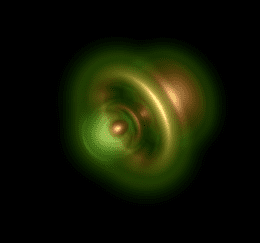When photons hit a material’s atoms, the interaction causes changes in state that happen extremely fast. Now, researchers have measured the duration of such a phenomenon with unbelievable accuracy, in the zeptosecond range (10-21 s).

At such tiny scales, weird things start to happen because we’re now in the domain of quantum mechanics. Based on current theoretical frameworks, physicists calculated that when light particles called photons hit a helium atom, the photon is either entirely absorbed by one of the atom’s two electrons or distributed among them. Regardless of the mode of transfer, one electron is always ejected from the helium atom – a process called photoemission, or the photoelectric effect as Albert Einstein called it at the beggining of the last century. This basic principle is what allows solar cells to generate electricity, for instance.
Physicists at LMU Munich and the Max Planck Institute of Quantum Optics wanted to observe in great sub-atomic detail what happens during this interaction. If you were to optically image photoemission, you’d need the fastest shutter speed camera in the world. That’s because the duration of the process, defined as the time between the first instant a photon interacts with electrons and the moment one electron is ejected, takes 5 to 15 attoseconds (10-18 seconds)
The German researchers fired light on helium atoms, then used an improved measurement method to capture events that occur on timescales down to 850 zeptoseconds. First, an attosecond-long, extremely ultraviolet (XUV) light pulse hit the helium atom to excite the electrons. Meanwhile, a second laser pulse fired infrared light at the same target which lasted far less, for about four femtoseconds (10-15 seconds).
As expected, an electron was ejected from the helium atom in response to the XUV light and subsequently detected by the infrared laser. The electromagnetic field of the XUV pulse oscillates and, depending on its state, can accelerate or decelerate the ejected electron. Simply by measuring this change in speed, we can establish the duration of the photoemission event – all with zeptosecond precision.
The findings published in Nature revealed for the first time how the energy of the incident photon is quantum mechanically distributed among the two helium electrons in the final few attoseconds before one of the particles is ejected.
“Our understanding of these processes within the helium atom provides us with a tremendously reliable basis for future experiments,” explains Martin Schultze, a specialist in laser physics at LMU’s Chair of Experimental Physics, who led the experiments at the MPQ. He and his team were able to correlate the zeptosecond precision of their experiments with theoretical predictions made by their colleagues in the Institute of Theoretical Physics at the Technical University of Vienna. With its two electrons, helium is the most complex system whose properties can be calculated completely from quantum theory. This makes it possible to reconcile theory and experiment. “We can now derive the complete wave mechanical description of the entangled system of electron and ionized helium parent atom from our measurements,” says Schultze.


